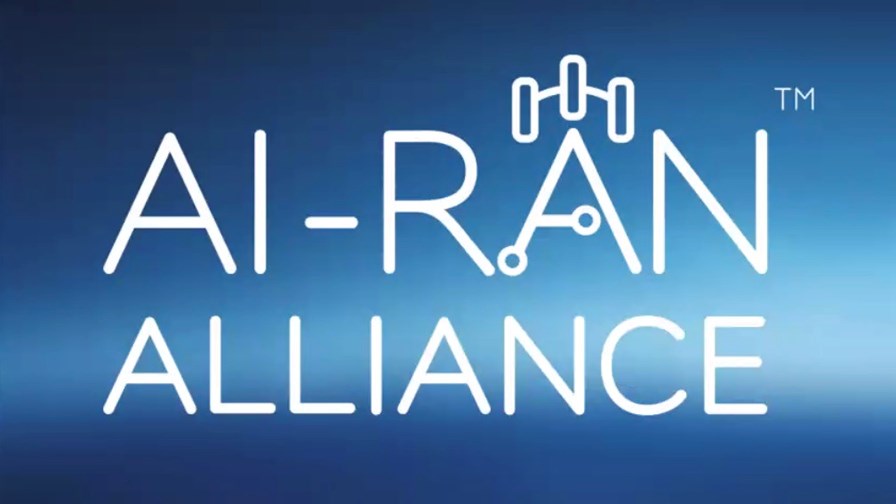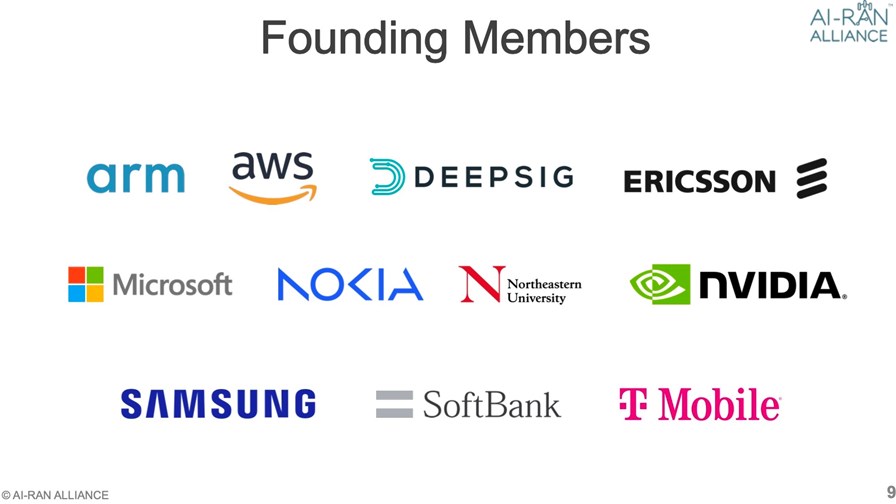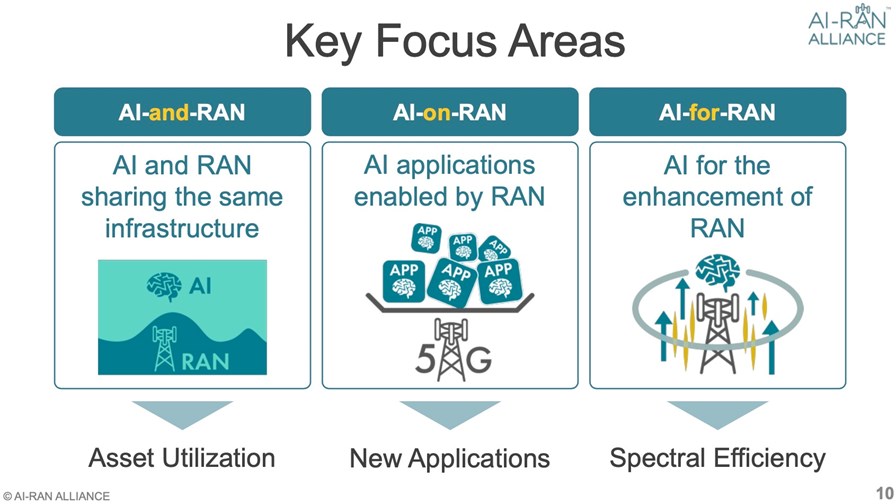
Source: AI-RAN Alliance
- A new industry group, the AI-RAN Alliance, has been unveiled on the first day of #MWC24
- It will undertake R&D on next-generation radio access network technology that has AI at its heart
- Founding members include some of the biggest names in mobile network technology and AI
- Ericsson, Nokia, Samsung, Nvidia, AWS and Microsoft are in the mix
- Two major telcos, Japan’s SoftBank and T-Mobile US, are also founding members
BARCELONA – #MWC24 – This year’s MWC kicked off with the announcement of a new telecom industry group, the AI-RAN Alliance, which boasts some of the industry’s biggest names as its founder members and sends a strong message to the mobile sector about the direction in which radio access network (RAN) architectures are heading.
The basic premise behind the alliance is that current RAN architectures are incredibly inefficient and with operators revamping their networks, becoming more cloud-oriented and desperately seeking the benefit from the automation and efficiencies that smart AI deployments could deliver, the industry now has the chance to develop blueprints for future RAN architectures that will enable mobile network operators to get a greater potential return on their investments and open up new revenue opportunities as well.
And the names that are launching the alliance include some of the biggest hitters from the mobile networking and AI sectors, including Amazon Web Services (AWS), Arm, Ericsson, Microsoft, Nokia, Nvidia, Samsung Electronics, SoftBank and T-Mobile US.

Source: AI-RAN Alliance
In terms of promoting the alliance and its endeavours, Nvidia, which has just reported record sales and profits driven by rampant uptake of its AI-enabling hardware and software, appears to be taking the lead. That’s not a surprise – the AI technology giant has been working on RAN system architectures that integrate AI applications, and the compute and storage technology needed to run them, for some time and last year began trials with SoftBank, another of the alliance’s founding members – see Nvidia and SoftBank team on GenAI, 5G/6G platform and Nvidia smells blood in the RAN.
And, currently, the technology stack needed to run multiple RAN and AI workloads on the same platform would come from Nvidia, so it’s keen to make the most of its current market leadership and capture the hearts, minds and (future) wallets of mobile operators.
Nvidia’s senior VP of telecom, Ronny Vasishta, outlined the current challenge faced by the mobile operator community during a media briefing session ahead of MWC24.
“The telecom industry has, over the last few years, been seeing a significant increase in the capex expense required” to deliver 4G and 5G services, but those investments haven’t delivered commensurate revenue increases for the service providers, noted Vasishta. “In fact, in many cases, we’re seeing declining revenues for the operators and the relative market size remains small… On the other hand, in terms of AI, we’re now experiencing a very large growth in AI infrastructure investments, and we anticipate that growth to continue and become a very large market… This is the dichotomy that is the backdrop to the AI-RAN Alliance,” he added.
“The goal of the alliance is to enable and accelerate what we’re terming AI RAN – that means AI combined with the radio access network… but also, part of the focus is using AI to address new revenue opportunities, and build the capabilities and the advantages and the functional benefits of AI into the radio access network ecosystem and to build out that ecosystem, which could include new entrants as well,” he continued.
There are three main focus areas for the alliance:
- AI for RAN – the use of AI tools to improve the performance and efficiency of radio access networks
- AI and RAN – the integration of AI and RAN processes on the same underlying infrastructure, so that the resources are constantly being used even if there is no mobile customer activity on the network, though with RAN processes prioritised when there is network activity
- AI on RAN – the development and deployment of AI-enabled applications at the edge of the network that can be delivered over 5G connections

Source: AI-RAN Alliance
Vasishta noted that the “goal of the alliance is to enable investigation in… those three areas and to [develop] some use cases, to enable whitepapers, blueprints, best practice documents, guidelines and recommendations” and feed those into the existing standards organisations. “The alliance is here really to explore and develop various use cases to solve some of these very complex challenges. It needs an ecosystem and it needs all layers in this ecosystem to work together… One of the biggest challenges has been the availability of data. AI requires data in order to really be effective and the data availability has been somewhat restricted, even though the data collection [capabilities] are there. So what we really want to do is now create an environment where data can be shared and datasets can be provided to enable the AI to be more efficient.” The alliance will also provide the facilities and capabilities for testing and verifying the blueprints.
The proposition – running a network that is more efficient and multifunctional, and enables the provision of new services – sounds like one that no network operator could ignore or turn away. Indeed, operators are already interested in how to move on from the current architecture and operating models: BT has spotted what SoftBank is doing with Nvidia and the UK operator’s director of network and spectrum strategy, Mark Henry, noted during a recent (but separate) media briefing that BT has invested a lot of capex into a network that only does one thing and is most often under-utilised – see Nvidia is the one to watch at MWC24.
But of course it’s not that simple because, as ever, embracing an AI-RAN architecture would mean investing heavily once again and operators are just about wiped out by their fibre access and 5G investments and are now looking to get some returns on those investments before emptying their wallets again. And the kind of technology platforms needed for AI RAN will not come cheap, especially now when AI chips are in high demand and short supply.
But for the broader mobile operator community this isn’t a here-and-now, take-it-or-leave-it moment – this is a RAN architecture proposition for the future, though it’s something that needs to be considered and planned for starting now.
Nvidia is keen to get the conversation going because it has the technology to enable it and Arm is on board too because Nvidia’s Grace Hopper superchip is based on its designs. Nvidia is also busy making plans with the RAN system developers, such as Nokia and Ericsson. And this is why the likes of Intel and AMD are not involved in the alliance – this isn’t in their wheelhouse just yet.
Nvidia’s argument with regards to the cost is that this kind of architecture, running multiple RAN, application and AI workloads, is efficient and delivers the kind of total cost of ownership (TCO) and return on investment (RoI) models that the mobile operators have been missing up to now. And as BT’s Mark Henry noted recently, the current RAN networks are very costly and they only do one thing.
It’ll be interesting to see who else joins the alliance. There are only two operators at the moment and SoftBank’s presence, given its existing work with Nvidia, is no surprise. Junichi Miyakawa, president and CEO of SoftBank, noted in the announcement about the launch of the alliance: “The AI-RAN Alliance has been formed with the vision to spearhead the advancement of society through AI innovations, particularly from the telecom industry... We are committed to leading the shift from traditional communication infrastructure to AI-powered next-generation social infrastructure.”
Perhaps more notable, though, is the inclusion of T-Mobile: This points to how that particular operator might be thinking about its cloud RAN and 5G evolution plans. John Saw, the US operator’s CTO, noted: “AI is coming faster than even many of the most ambitious predictions. With our 5G network advantage, we’re in a unique position to capitalise on the opportunity. Developing an ecosystem of AI-based solutions for the design, engineering, and operation of our network and services, with so many category leaders in this alliance, is a powerful way to accomplish more than we could alone.”
The telecom sector has many alliances and lots of collaborations, many of which fade away over the years into obscurity. The AI-RAN Alliance looks like one that will have staying power because it’s focused on some very critical areas of potential development for the hundreds of mobile operators around the world that are trying to figure out the best ways to be more efficient, embrace AI and better deliver the services that customers want.
If the alliance members can come up with some blueprints that will please the CFOs as well as the CTOs, then it’ll be onto a winner.
- Ray Le Maistre, Editorial Director, TelecomTV
Email Newsletters
Sign up to receive TelecomTV's top news and videos, plus exclusive subscriber-only content direct to your inbox.




